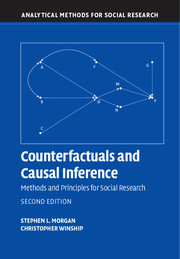Refine search
Actions for selected content:
2348 results in Statistical theory and methods
7 - Algorithms and Computation
-
- Book:
- Nonparametric Estimation under Shape Constraints
- Published online:
- 18 December 2014
- Print publication:
- 11 December 2014, pp 155-196
-
- Chapter
- Export citation
Preface and Acknowledgments
-
- Book:
- Nonparametric Estimation under Shape Constraints
- Published online:
- 18 December 2014
- Print publication:
- 11 December 2014, pp ix-xii
-
- Chapter
- Export citation
11 - Pointwise Asymptotic Distribution Theory for Univariate Problems
-
- Book:
- Nonparametric Estimation under Shape Constraints
- Published online:
- 18 December 2014
- Print publication:
- 11 December 2014, pp 313-359
-
- Chapter
- Export citation
10 - Asymptotic Theory of Smooth Functionals
-
- Book:
- Nonparametric Estimation under Shape Constraints
- Published online:
- 18 December 2014
- Print publication:
- 11 December 2014, pp 283-312
-
- Chapter
- Export citation
Author Index
-
- Book:
- Nonparametric Estimation under Shape Constraints
- Published online:
- 18 December 2014
- Print publication:
- 11 December 2014, pp 409-411
-
- Chapter
- Export citation
5 - Higher Dimensional Problems
-
- Book:
- Nonparametric Estimation under Shape Constraints
- Published online:
- 18 December 2014
- Print publication:
- 11 December 2014, pp 121-138
-
- Chapter
- Export citation
6 - Lower Bounds on Estimation Rates
-
- Book:
- Nonparametric Estimation under Shape Constraints
- Published online:
- 18 December 2014
- Print publication:
- 11 December 2014, pp 139-154
-
- Chapter
- Export citation
9 - Testing and Confidence Intervals
-
- Book:
- Nonparametric Estimation under Shape Constraints
- Published online:
- 18 December 2014
- Print publication:
- 11 December 2014, pp 226-282
-
- Chapter
- Export citation
1 - Introduction
-
- Book:
- Nonparametric Estimation under Shape Constraints
- Published online:
- 18 December 2014
- Print publication:
- 11 December 2014, pp 1-17
-
- Chapter
- Export citation
Subject Index
-
- Book:
- Nonparametric Estimation under Shape Constraints
- Published online:
- 18 December 2014
- Print publication:
- 11 December 2014, pp 412-416
-
- Chapter
- Export citation
12 - Pointwise Asymptotic Distribution Theory for Multivariate Problems
-
- Book:
- Nonparametric Estimation under Shape Constraints
- Published online:
- 18 December 2014
- Print publication:
- 11 December 2014, pp 360-377
-
- Chapter
- Export citation
4 - Other Univariate Problems Involving Monotonicity Constraints
-
- Book:
- Nonparametric Estimation under Shape Constraints
- Published online:
- 18 December 2014
- Print publication:
- 11 December 2014, pp 87-120
-
- Chapter
- Export citation
Frontmatter
-
- Book:
- Nonparametric Estimation under Shape Constraints
- Published online:
- 18 December 2014
- Print publication:
- 11 December 2014, pp i-iv
-
- Chapter
- Export citation
13 - Asymptotic Distribution of Global Deviations
-
- Book:
- Nonparametric Estimation under Shape Constraints
- Published online:
- 18 December 2014
- Print publication:
- 11 December 2014, pp 378-400
-
- Chapter
- Export citation
2 - Basic Estimation Problems with Monotonicity Constraints
-
- Book:
- Nonparametric Estimation under Shape Constraints
- Published online:
- 18 December 2014
- Print publication:
- 11 December 2014, pp 18-46
-
- Chapter
- Export citation
8 - Shape and Smoothness
-
- Book:
- Nonparametric Estimation under Shape Constraints
- Published online:
- 18 December 2014
- Print publication:
- 11 December 2014, pp 197-225
-
- Chapter
- Export citation
Contents
-
- Book:
- Nonparametric Estimation under Shape Constraints
- Published online:
- 18 December 2014
- Print publication:
- 11 December 2014, pp v-viii
-
- Chapter
- Export citation

Counterfactuals and Causal Inference
- Methods and Principles for Social Research
-
- Published online:
- 05 December 2014
- Print publication:
- 17 November 2014
3 - Causal Graphs
-
- Book:
- Counterfactuals and Causal Inference
- Published online:
- 05 December 2014
- Print publication:
- 17 November 2014, pp 77-102
-
- Chapter
- Export citation
VI - Conclusions
-
- Book:
- Counterfactuals and Causal Inference
- Published online:
- 05 December 2014
- Print publication:
- 17 November 2014, pp 435-436
-
- Chapter
- Export citation
